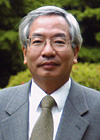

|
Program Keynote Speakers << Back |
 Shoogo Ueno
Shoogo UenoProfessor Emeritus, Graduate School of Medicine, University of Tokyo, Tokyo, Japan Professor, Department of Applied Quantum Physics, Graduate School of Engineering, Kyushu University, Fukuoka, 812-8581 Japan RECENT ADVANCES IN BIOMAGNETICS AND BIOIMAGING FOR BRAIN RESEARCH AND SENSING TECHNOLOGIES Biomagnetics is an interdisciplinary field where magnetics, biology and medicine overlap. Biomagnetics has a long history since 1600 when William Gilbert published his book "De Magnete". Recent advances in biomagnetics have enabled us not only to detect extremely weak magnetic fields from the human brain but also to control cell orientation and cell growth by using extremely high magnetic fields. Pulsed magnetic fields are used for transcranial magnetic stimulation (TMS) of the human brain, and both high frequency magnetic fields and magnetic nano-particles have promising therapeutic applications for the treatments of cancers and brain diseases such as Alzheimer's and Parkinson's. On the imaging front, magnetic resonance imaging (MRI) is now a powerful tool for basic and clinical medicine. New methods of MRI based on the imaging of impedance of the human body, called impedance MRI, and the imaging of neuronal current activities in the human brain, called current MRI, are also being developed. The present key note lecture focuses on the recent advances in biomagnetics and bioimaging based on achievements obtained mostly in our laboratory in recent years. The lecture includes (1) a method of localized magnetic stimulation of the human brain by TMS with a figure-eight coil, (2) magnetoencephalography (MEG) by superconducting quantum interference devices (SQUIDs), (3) impedance MRI and current MRI, (4) cancer therapy and control of iron-ion release/uptake from/into ferritin, iron storage protein, by using both high frequency magnetic fields/pulsed magnetic fields, (5) measurements of iron content and amyloid aggregation via radiative decay modifications, and (6) magnetic control of cell orientation and cell growth by static high magnetic fields. These new biomagnetic approaches will open new horizons in brain research, brain treatments and regenerative medicine. |
|||
Copyright 2008, All Rights Reserved, IEEE Sensors 2009 and interteq.com